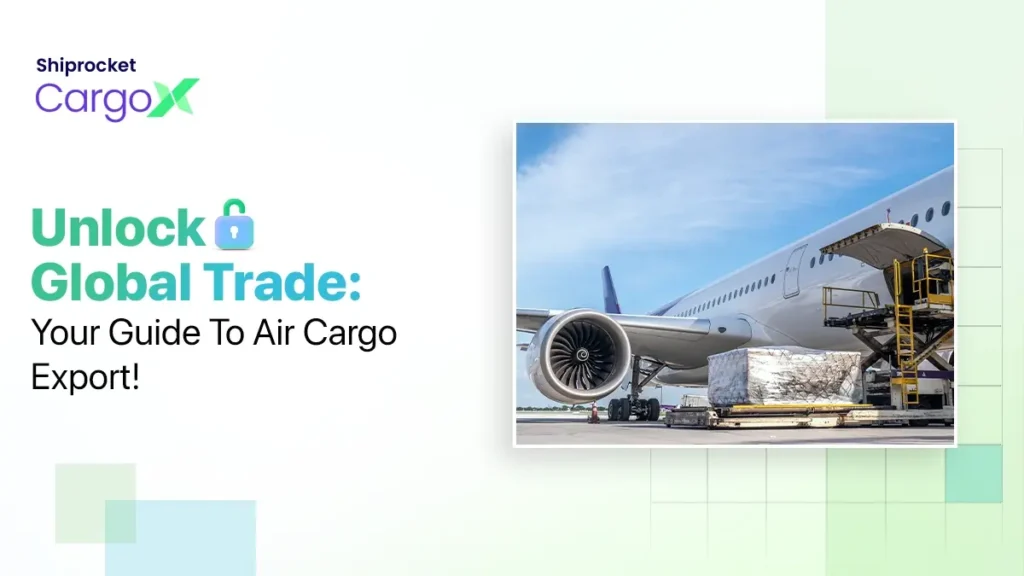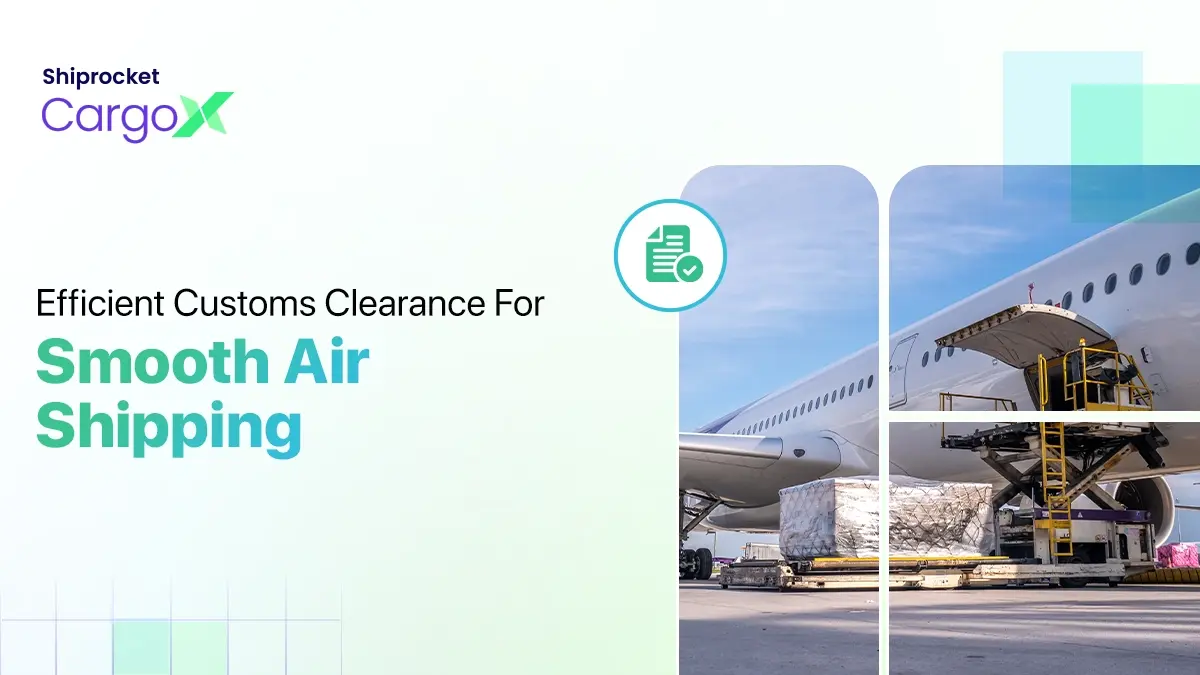Air Cargo Export: Benefits, Process & Key Documents
- A Shipper’s Guide to Air Cargo Shipping Process
- Detailed Breakdown of the Air Freight Shipping Process
- Post-Flight Procedures and Handling
- Roles And Responsibilities Of Various Stakeholders In Air Cargo Export
- Different Types Of Air Cargo
- Key Documents Required For Air Cargo Export
- Shiprocket’s CargoX: Effortless Global Logistics
- Conclusion
Understanding the role that air freight plays in the global trade ecosystem is essential for eCommerce business owners. One of the main components that makes international freight movement quick and easy is air cargo. Air freight is a vital tool for businesses looking to reach international markets. It can carry over USD 6 trillion worth of products yearly, making up around 35% of global trade by value. Air freight provides unmatched speed, dependability, and security over other forms of transportation, even with its higher prices and more strict regulations.
Here, we’ll look at an in-depth review of the air cargo export shipping procedure.

A Shipper’s Guide to Air Cargo Shipping Process
Knowing how air cargo shipping operates is essential if you want to employ air freight for your company and make improvements. This guide can help you in gaining an understanding of the air freight export shipping procedure.
Significance Of Air Cargo Export In Global Trade
Let’s start with exploring the significance of air cargo in global trade:
Facilitating Global Trade:
Air transport is an important part of international trade because it allows businesses to easily access international markets across the globe. Air freight is a useful tool for expanding your eCommerce business. This mode of transportation allows you to effortlessly deal with different nations for the export and import of several products and services. This helps to expand your role in the global economy.
Expanding Market Reach and Productivity:
Air cargo is more than just a means for delivering products. It’s also about increasing productivity and expanding into new markets. By strengthening your relationships with global sectors, air freight helps increase your revenue by allowing you to trade worldwide. Industries such as technology and pharmaceuticals have grown rapidly as a result of reliable air connections, which makes it easier to expand the market reach.
Increasing the Productivity of the Supply Chain:
Keeping the supply chain running properly is important for the success of any eCommerce firm. Deliveries made by air freight are more dependable and fast. It is very beneficial to decrease delivery time. You can ensure your clients receive their purchases on time by choosing air freight for shipping.
Developing Networks and Partnerships:
Air transport is more than simply transferring goods; it also connects businesses throughout the world. This implies that you can collaborate with global businesses. This can help you improve the services you provide and grow your company.
Growing Opportunities with Air Freight:
The chances for your company to expand globally are higher because of the commendable services offered by the air cargo industry in reaching any of the locations around the globe. By seizing this opportunity, you can improve your logistics and guarantee that your goods reach your clients more quickly. In the global economy, this can assist your company grow and become profitable.
Detailed Breakdown of the Air Freight Shipping Process
From the origin to the destination, there are several steps in the air freight shipping procedure. Here is a complete description of pre-flight procedures and checks, as well as post-flight protocols and handling.
Pre-Flight Procedures and Checks
Understanding the procedures needed to be completed before the shipment of your items is crucial if you manage an online store:
Step 1: Assembling Your Package:
Gather every item that your clients have requested and then have the packaging materials ready. Make a list of the products you are sending in inventory.
Step 2: Packing Your Goods:
Carefully pack your products in boxes, making sure to name each one accurately. Paperwork and security will be handled by your shipping company.
Step 3: Making Use of a Freight Forwarding Firm:
Deliver your items to the warehouse of a freight forwarding firm, and they will be wrapped and labelled there. When your shipment is accepted by the forwarder, they will give you a Proof of Acceptance.
Step 4: Pre-Flight Inspections:
Carry out critical inspections ahead of the shipment of your items. Make sure you have all the necessary customs papers and the product labels are accurate. Update them as needed.
Post-Flight Procedures and Handling
To properly manage cargo and post-flight operations, you should take the following actions:
- Prepare for Cargo Transport: Prepare to convey the cargo from the aeroplane to the appropriate place after it has landed
- Accept and Disassemble ULDs: To properly accept and disassemble Unit Load Devices (ULDs), follow the applicable instructions.
- Examine any incoming shipments: To ensure that everything is on order, check the incoming shipments along with the supporting documentation.
- Get Ready for Warehouse Storage: Arrange for the warehouse to hold the received products while adjusting the flight manifest.
- Out for Delivery: After everything has been examined and approved, put the products into vehicles so they can be delivered to their destination.
- Receiving Shipment: Make sure the right number of products are included and thoroughly examine every item for any obvious damage as soon as the shipment is delivered. After everything has been verified, issue a Proof of Delivery (POD).
- Unload and Check for Damage: Unpack the products and carefully check them for any damage sustained during transit. To determine whether any items are missing, count the received products with the packing list or purchase order. Arrange procedures for warranty claims and, if necessary.
- Custom Declaration: Organise any necessary customs declarations at the air cargo terminal.
Roles And Responsibilities Of Various Stakeholders In Air Cargo Export
To operate an eCommerce business successfully you must understand the roles and responsibilities of the various individuals engaged in the export of air cargo. Let us examine the main stakeholders in this process and their respective roles:
Shippers (Consignors):
- Pack your products with care to ensure they reach their destination intact.
- Verify that any necessary paperwork, including invoices and customs declarations, is correct and complete.
- To ensure that you comply with safety and security regulations needed for the products you are delivering.
- Collaborate closely with carriers or goods forwarders to guarantee smooth transit.
Freight Forwarders:
- Freight forwarders guide you through the process of documentation and ensure that everything is according to the rules.
- They can also modify shipping routes to save costs while maintaining efficiency.
- They also provide updates about the status of your cargo.
- Customs clearance is one of the most important services that they can provide to fast-track the procedure
Airlines/Carriers:
- It is the duty of airlines or carriers to deliver your cargo quickly and safely.
- They also oversee the loading and unloading of cargo at the terminals..
Ground Handling Agents:
- It is the duty of the ground handlers to supervise the acceptance, inspection, and preparation of goods at airports.
- They also guarantee effective handling and provide certain amenities for special cargo like temperature-controlled storage spaces, etc.
Customs Authorities:
- Customs agents verify that your necessary paperwork is in order, ensuring efficiency.
- They are responsible for collecting all relevant taxes and customs charges.
- They are also responsible for implementing security measures in order to stop any illegal movement of commodities.
Warehouse Operators:
- When your products arrive, warehouse employees handle and store them properly.
- They maintain tabs on your stock and immediately complete orders.
- When necessary, it can offer value-added services like labelling or repackaging services.
Role of Regulatory Agencies:
- Regulatory bodies create and enforce regulations that ensure compliance with safety standards.
- They grant licences and certifications to carriers and forwarders so they can conduct business legally.
- They help in upholding safety standards, and regulatory bodies investigate incidents or failures.
Understanding each stakeholder’s duties and obligations will help you to achieve regulatory standards and customer demands while ensuring a seamless flow of goods across the transportation chain.
Different Types Of Air Cargo
Here are different types of cargo that you should know about
- General Cargo: This includes daily cargo such as electronics, apparel, mechanical components, etc. As a business owner, you’ll most likely depend on air freight services to move your general products quickly and efficiently. The packing and handling requirements for general cargo are often easy, making the process more efficient than other types of cargo.
- Special Cargo: If you’re shipping artistic works or prescription medications, perishable goods, etc you’ll require special cargo services. These commodities demand specific handling, storage, or shipping requirements that necessitate the need for special attention. Special cargo service providers are prepared to manage these demands and guarantee adherence to regulations. There are several subcategories within this category.
- Live Animals: If your cargo involves transportation of live animals including pets and endangered species there are special services that you can use. These services protect the welfare and safety of animals in transportation, and. Rules to govern such cargo are established by bodies such as the International Air Transport Association (IATA).
- Hazardous or Dangerous Cargo: Handling dangerous products, such as medicines or chemicals requires unique shipping conditions. You have to follow stringent guidelines when shipping such goods. To guarantee the security of both individuals handling the product and the aircraft, these regulations govern the handling, labelling, and packaging process.
- High-worth or Fragile Cargo: Because of its high value or fragility, products like expensive fine art or luxurious items need to be treated cautiously and protected with certain security measures. To safeguard these goods during transit, air cargo carriers offer enhanced care and safety precautions.
- Perishable Cargo: For perishable goods like fresh fruit or seafood need special services that guarantee proper packing and temperature management so that they arrive at their destination swiftly and safely.
- Temperature-Controlled Cargo: Temperature-controlled air freight services are crucial for products that are sensitive to temperature changes, such as food and medications.
- Mail Cargo: If you’re shipping letters, documents, or small parcels, you’ll utilise mail cargo services. These services ensure the prompt delivery of mail and packages worldwide, collaborating closely with customs agencies to comply with shipping regulations.
- Human Remains, Tissue, and Organ Cargo: In sensitive situations involving human remains, tissues, or organs, specialised air cargo services are crucial. These services adhere to strict regulations and guidelines to ensure these items’ ethical and safe transport, often collaborating with medical institutions and organ transplant organisations.
By understanding these different types of air cargo and the services available, you can efficiently make informed decisions to transport your goods as an e-commerce business owner.
Key Documents Required For Air Cargo Export
Here are a few important documents you will come across:
- Airway Bill (AWB): This document serves as your contract of carriage and contains important facts about the shipper, consignee, and flight itinerary.
- Commercial Invoice: This record of your transaction contains details about the products that were transported, including their description and value. It is used for custom valuation purposes.
- Packing List: The contents of each package or container of your shipment are listed in the packing list. It ensures accurate tracking and helps to prevent loss.
- Certificate of Origin: This document certifies the country of origin of your items. It is necessary for assessing applicable trade agreements and tariffs.
- Bill of Lading: This document is used to acknowledge cargo receipt for shipping in air freight.
- Customs Declarations: These documents, which are necessary for import and export procedures, are needed by customs officials and include important information about your shipment.
- Transportation Security Administration (TSA) Documentation: Be mindful of any special requirements established by the TSA to guarantee the security of flying cargo if your shipment travels to the United States.
Shiprocket’s CargoX: Effortless Global Logistics
As an eCommerce business owner, Shiprocket’s CargoX is your go-to solution for hassle-free cross-border shipping. It can streamline international air cargo export operations, ensuring effective management. You can manage bulk shipments by partnering with CargoX. They ensure prompt delivery by guaranteeing pickup within 24 hours of placing the order. Clear and transparent billing is also offered, along with full visibility of goods from pickup to delivery.
Their global network of over 100 nations facilitates customs clearance, which promotes the global expansion of businesses.
It also provides customised shipment schedules. You can choose from a range of customisable courier services which suit your schedule and budget requirements as well as ensure fast delivery to any location around the world.
Conclusion
Air freight shipping offers several significant benefits for international trade operations. Air cargo export provides a swift and efficient means to transport time-sensitive goods to any corner of the globe. By leveraging this option, your small business can seamlessly integrate into the global market, ensuring speedy delivery and meeting customer demands effectively. So, remember to follow the guidelines outlined to optimise your air freight shipping strategy and propel your business towards international success.




